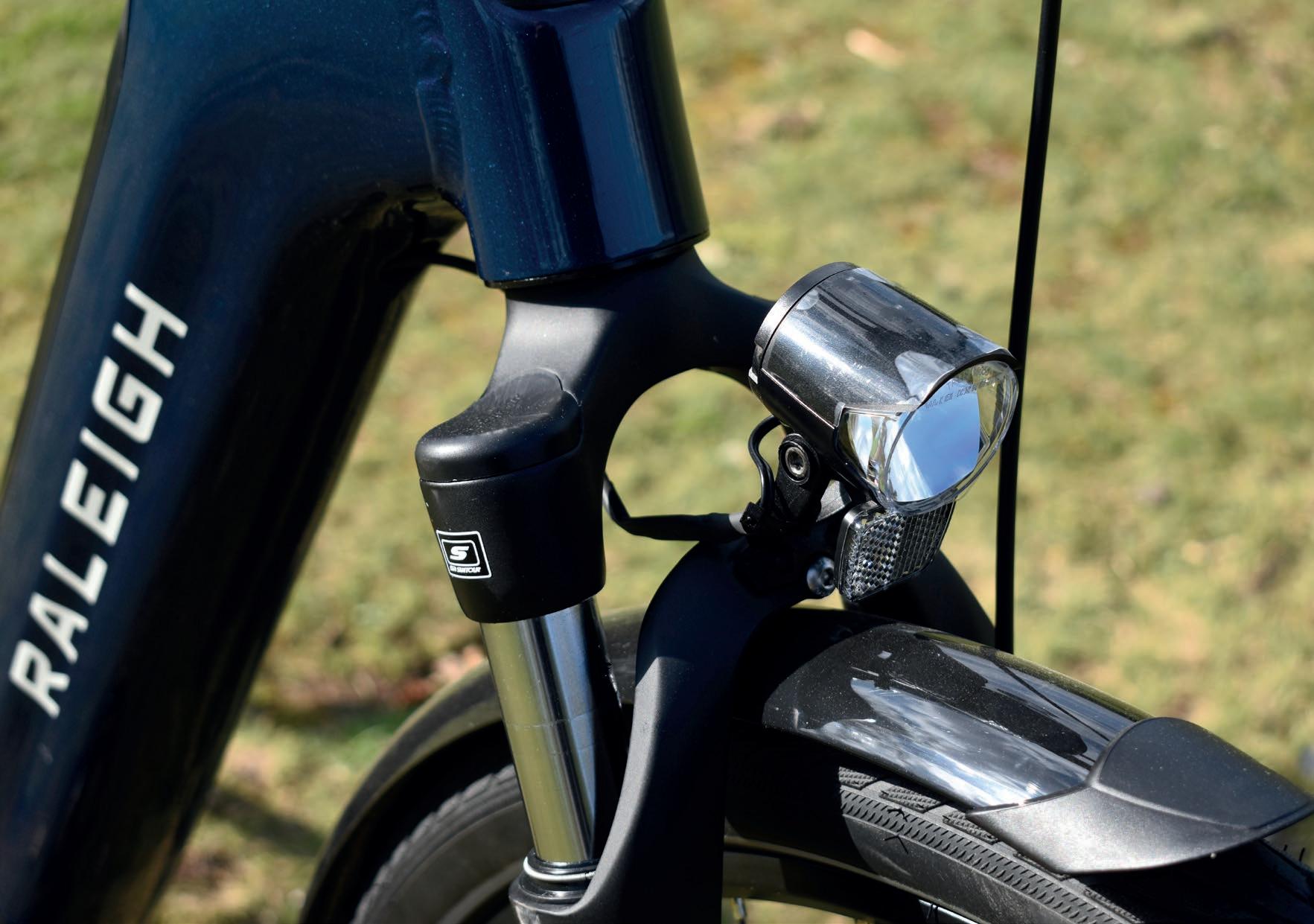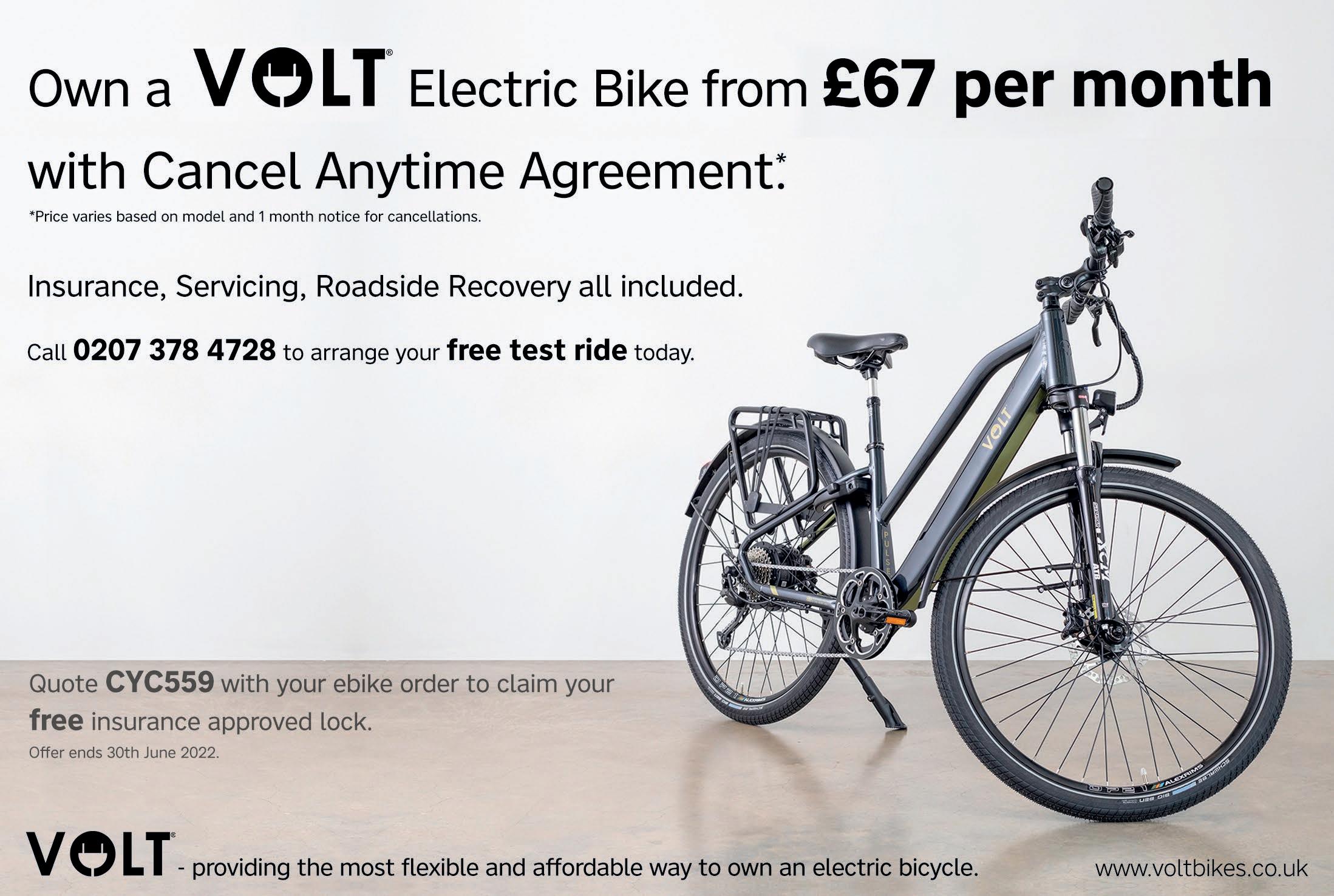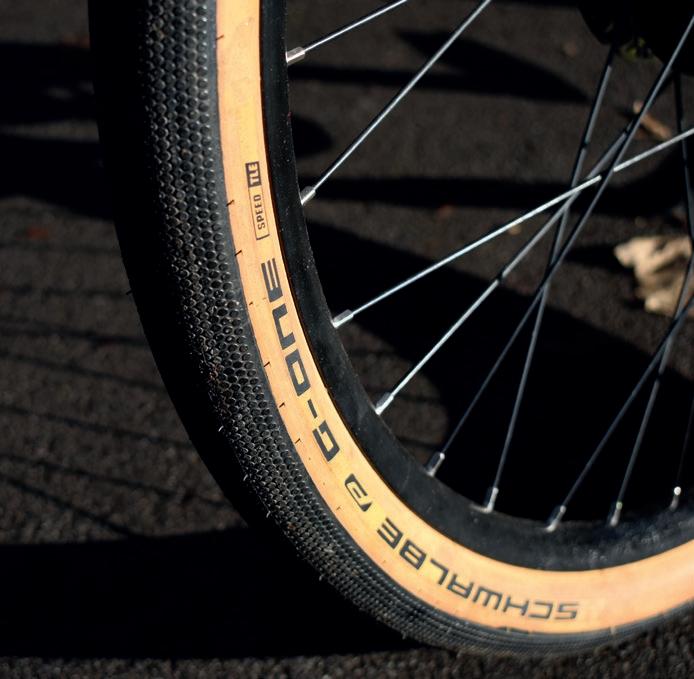
10 minute read
Electric commuters
Biketest

RICHARD PEACE
Richard is a cycling journalist and author. His books include Electric Bicycles and Sustrans’ Traffic-Free Cycle Rides (p28)
Electric commuters
Urban transport is one of the most important roles for e-bikes. Richard Peace tests a Raleigh New Motus Tour Plus and a Volt London
You can ride to work on any e-bike. For this test I’m defining ‘commuter e-bikes' as machines that are practical, utilitarian, and durable – the kind of e-bikes that might persuade someone to get out of their car for the journey to work and keep doing so even in bad weather. This is where the ‘e’ in e-bikes is so important: that electrical assistance makes cycle commuting so much easier on a rainy Monday morning.
The test models contrast nicely. Raleigh’s New Motus Tour Plus is part of an extended New Motus range for 2022. This one has an 8-speed hub gear and sits towards the top end in terms of spec. It’s clearly aimed at cyclists who just want to get from A to B comfortably and easily.
The Volt London, also new for 2022, is a singlespeed. Despite its minimalist looks, it still has everything you need for commuting. And while non-electric singlespeeds are traditionally seen as a sporty niche, the addition of a motor makes a onegeared bike an option for anyone. Volt is London based and has many years of experience in producing only e-bikes.
Frame & fork
The Raleigh New Motus has a stepthrough frame with a huge down tube, which provides frame stiffness without triangulation. The big tube also houses the battery. By contrast, being a classic diamond frame design, the Volt London has a much slenderer appearance.
Although both test bikes have a similar middling frame size, the Raleigh is a much bigger e-bike. That impression is reinforced by its high front end compared to the racier design of the Volt frame. The Raleigh comes in five sizes (I tested the middle one), while the Volt comes in a single size. Tall or short riders are therefore more likely to find a Raleigh that accommodates them comfortably.
A heavyweight hub-geared roadster whose Bosch mid-motor makes commuting a breeze

The Raleigh's upright position is confidence inspiring, making it ideal for new cycle commuters

The Raleigh is the heavier e-bike by almost 6kg. This will matter more to some cyclists than others. Compared to nonelectrics, weight is less of an issue with e-bikes as you have a motor to help you up the hills. However, if weight is important to you – for example, if you need to regularly carry the bike up steps – neither model is particularly light. (A lighter e-bike from the likes of Ampler or Ribble may suit you more in that case.) The Raleigh has a ‘sit up and beg’ frame and is clearly aimed at riders prioritising comfort, whereas the Volt has the slightly leaning forward riding position typical of a sports hybrid.
As with the vast majority of e-bike frames today, both are sturdily built with neatly welded joints. Both frames are very nicely finished too, the Raleigh in a lustrous, semi-metallic dark paint described as ‘deep sea blue'. The Volt is brushed aluminium, giving the frame the look of stainless steel.
Brake, gear and electrical cabling is internally routed in both cases, though
slightly neater on the Raleigh where it enters via the oversize head tube and exits via the chainstays. On the Volt, cables enter the underside of the down tube near the head tube and exit near the bottom bracket, leaving cable runs a little more exposed at the rear of the bike. The Volt comes equipped with a porteurstyle front rack and has fittings for a rear rack. The Top: Bosch’s Purion display is Raleigh has a rear rack but compact and easy to use won’t take most front ones. Bottom: Maximum torque is ‘only’ 50Nm but the Bosch The forks underscore the Active Line Plus mid-motor different riding styles the benefits from the bike’s wide- bikes are designed for. The ratio 8-speed hub gear so the Raleigh climbs well enough Raleigh has a Suntour NEX suspension fork with 52mm of steel-sprung travel. The Volt has a rigid aluminium fork that's finished in matt black, perhaps to give the impression of a carbon fork.
Components
The most obvious contrast here is in the motor systems. The Raleigh features a mid-drive (also known as a crank drive) from market leader Bosch. It’s undoubtedly high quality and also carries Bosch’s impressive battery guarantee of a minimum of 60% of full charge capacity
Tech Spec
RALEIGH NEW MOTUS TOUR PLUS – HUB GEAR
Price: £2,495
Sizes: 41, 46, 51 (tested), 56, 61cm
Weight: 27.4kg/60.4lb
Frame & fork: Aluminium 6061 stepthrough frame with mid-drive housing and removable frame-integrated battery in down tube. Suntour NEX steel spring suspension fork with 52mm travel.
Wheels: 50-622 Schwalbe Road Cruiser tyres, 36-hole double wall rims, QR aluminium hubs, 14G spokes. Transmission: Shimano Nexus 8-speed hub gear with 38t chainwheel and 19t rear sprocket. Shimano Nexus twistgrip shifter. Eight ratios: 31-94in. Electronics: Bosch Active Line Plus mid-drive motor with 400Wh frame-integrated Bosch PowerTube battery. Bosch Purion handlebar display. Braking: Alhonga hydraulic disc brake, 180mm front rotor, 160mm rear rotor. Alloy levers. Steering & seating: XLC ergonomic grips, 640mm aluminium City Rise bar, 85mm adjustable stem. Selle Royal Saddle, 31.6×300mm seatpost.
Equipment: Herrmans MR.GO front light, AXA Juno rear light (both hardwired), Eurofender full mudguards, Motus MIK compatible rear rack, adjustable kickstand. raleigh.co.uk
Dimensions in millimetres and degrees 650-680 610
726 44 n/a 72˚ 510 60
687 480 130


A sportier singlespeed that almost anyone can honk up hills thanks to its hub motor


for two years or 500 charge cycles, whichever comes first. In practice, I would expect a well cared-for battery to last much longer.
The Bosch Active Line Plus motor seems well paired with the relatively small 400Wh battery. It’s only one up from the least powerful Active Line in the Bosch family of motors so it won’t have the oomph of Bosch Performance Line motors. However, the 8-speed Shimano Nexus hub gear lets you leverage motor power across a wide speed range, so the bike can easily get up just about any road gradient – just not quite as quickly as more powerful mid-drives. If you live in a very hilly area, a larger rear sprocket can always be fitted for easier climbing.
The Volt employs a far more unusual drive system. It features a Bafang rear hub motor (common enough), torque sensing (unusual with a hub motor) and a throttle trigger (much more unusual). The company has clearly thought about the spec here and matched it to the characteristics of a singlespeed e-bike. With power assist needed to overcome
the inertia of singlespeed gearing from the second you put pressure on the pedals, torque sensing is certainly the way to go. On paper it looks an ideal combination. You may have read that throttles are illegal on e-bikes in the UK but in fact it’s throttle-only operation that is illegal. Throttles are allowed if they can be operated either independently up to 4mph Top: Good torque sensing means the hub motor kicks in (walk-assist style) and/or as soon as you press on the give full legal motor power pedals, so it’s easy to get the only while the pedals are singlespeed gear turning Bottom: A rear wheel lock is a turning. An instantaneous practical addition power boost provided by a powerful throttle can be a very great help on a singlespeed. Both bikes have 50mm-wide tyres for a good amount of comfort. The Schwalbe G-One tyres on the Volt are superior to the Schwalbe Road Cruiser Plus on the Raleigh, having equivalent or better road speed and more grip in gravel bike conditions such as on forestry roads and towpaths. Both bikes feature LED lights with enough power for good visibility on unlit roads, and both have a full complement
Tech Spec
VOLT LONDON
Price: £2,199
Sizes: 48cm (one size)
Weight: 21.7kg/47.8lb
Frame and fork: 6061 T6 aluminium alloy frame, aluminium alloy fork. Mounting points for optional bespoke rear rack on inside of rear triangle.
Wheels: 50-584 Schwalbe G-One tyres, 36-hole Alex DP21 double-wall rims, 13G spokes.
Transmission: Single gear. One ratio: 72in.
Electronics: Bafang rear hub motor with Spintech control technology. 504Wh frame-integrated battery with Panasonic cells.
Braking: Tektro Auriga hydraulic disc brakes (as tested).
Steering & seating: Fabric silicone grips, 640mm alloy flat handlebar, 85mm Zoom alloy stem. Fabric gel radius saddle, 28mm dia. EXA suspension seatpost.
Equipment: Front and rear hardwired Spanninga LEDs. Front alloy porteur-style rack as standard with rear rack optional. Full length SKS mudguards. Lock voltbikes.co.uk
Dimensions in millimetres and degrees 683 580
687
55 780 73.5˚ 503 60
655 455 133
Cycle’s test promise
At Cycle, we are proudly independent. There’s no pressure to please advertisers as we’re funded by your membership. Our product reviews aren’t press releases; they’re written by experienced cyclists after thorough testing.
Above: 504Wh battery locks securely in place… Near right: …as does the Raleigh’s 400Wh battery Top right: The Volt’s fast-rolling gravel tyres Bottom right: Porteur rack scores hipster points




of commuting extras: mudguards, kickstand, and rack. The SKS mudguards on the Volt seem more durable than the rather plasticky affairs on the Raleigh. The Raleigh also has similarly flimsy-feeling plastic on the battery and motor covers, while the metal catch on the battery cover looked like it could easily scratch your lovely frame unless closed carefully. The Volt’s 504Wh battery is a very sturdy feeling, onepiece, all-metal design. Both batteries lock in their frames very securely
The ride
The Raleigh is comfortable to ride and its upright position is confidence inspiring, making it ideal for new and returnee cycle commuters who want a bike that helps them feel safe and secure in traffic. Many riders say electric-assist is a boon in busy town traffic too, allowing a quick getaway at junctions and lights. The Raleigh’s torque sensing mid-drive is quiet and smooth, and the four power levels are easy to toggle through to find just the right level of assistance. Gear shifting with the twistgrip shifter is intuitive and can be done while stationary.
The Volt is reasonably comfortable, although I found the suspension seatpost totally ineffective, the spring being too stiff for my 68kg weight. Sportier and slightly fitter riders will likely enjoy the Volt most, as you have to put in more effort on hills. I loved the combination of smooth torque sensing and punchy throttle power. I found myself standing out of the saddle for maximum pedal pressure quite often. It feels fast and smooth, and I even made it up a short 25% gradient, though I wouldn’t want to be tackling that kind of hill too often. (The Raleigh tootled up sedately and easily.) If it’s only moderately hilly where you live, the Volt could prove a fast, effective and lowmaintenance getabout.
You might assume that the 504Wh battery on the Volt would give more range than the 400Wh battery on the Raleigh. However, I found 30 miles was a fair range estimate for both e-bikes over pretty hilly country. As ever there are so many variables it’s difficult to pin down a single figure.
Other options
CUBE TOURING HYBRID ONE 400
£2,399
A bit sportier geometry than the Raleigh with a more powerful Bosch mid-drive, though the same size battery. You can pay extra for 500Wh or 625Wh versions. cube.eu
TENWAYS CGO600
£1,499
Successful Kickstarter torquesensing singlespeed with belt drive. Significantly lighter than the Volt but with a smaller, non-removable battery. tenways.com
Verdict
Both bikes are well designed for commuting but would suit very different riders. The Raleigh is a great introduction to dependable, safe, easy and lowmaintenance electric commuting.
The Volt is geared (sic) more towards those with cycling experience. If you’ve tried a non-electric singlespeed in the past and found it too hard, don’t be put off: electric-assist transforms the ride. Powering up hills is much easier, yet the simplicity of a single gear makes it an engaging daily runaround.








